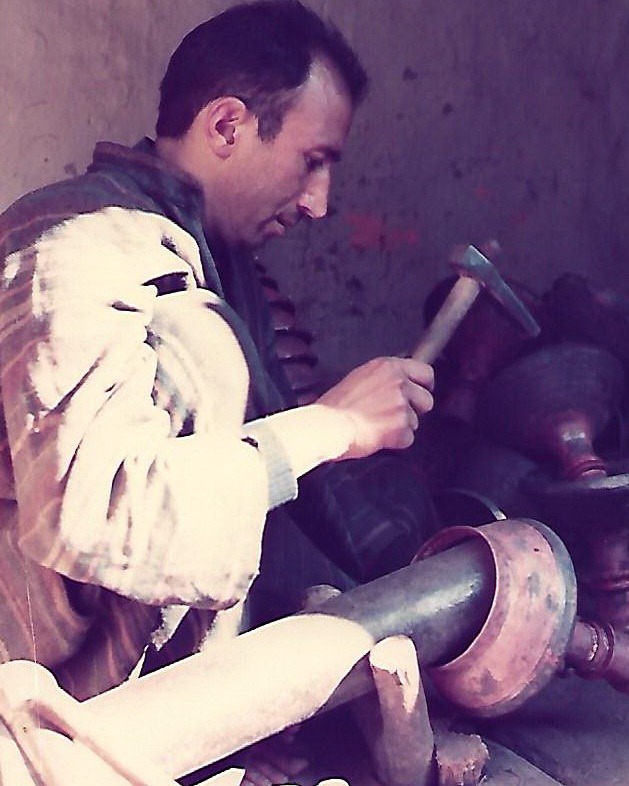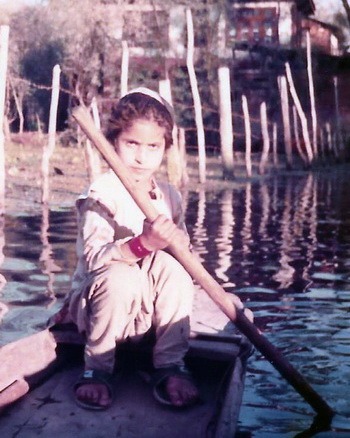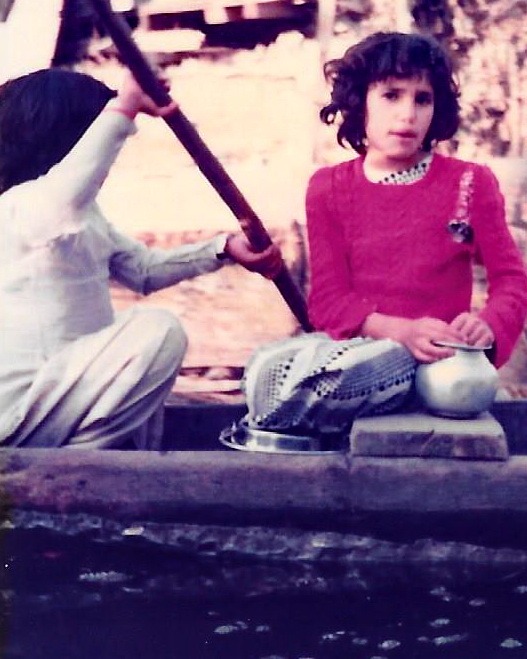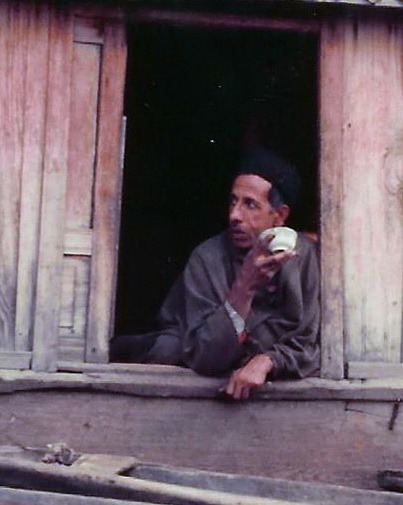Dal Lake, Srinagar, Kashmir, 1987
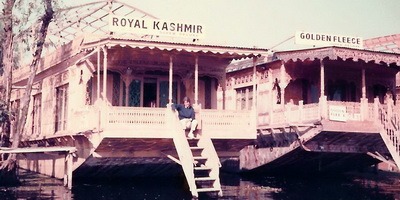
We flew to Srinagar, the capital of the Indian state of Kashmir, in autumn 1987. We had just spent a few days in Delhi, after several weeks in Pakistan. A stay on a Srinagar houseboat was not on our itinerary for India, but an American we travelled with in Rawalpindi, Peshawar and the Swat valley suggested it would be a good place to relax and take stock before resuming our travels in the Subcontinent. And what a good decision it turned out to be. The story below is adapted from my trip diary.
In the early morning the air is crisp and cold, a thin layer of mist drifts above the water, which is smooth as glass. A few boats left over from the 6:30am market (too early for us!) paddle past our houseboat, laden with cauliflowers, turnips, cabbages and radishes; an occasional flower seller drifts serenely by, brimming with chrysanthemums, michaelmas daisies and marigolds in oranges, reds, yellows and purples. These wooden, flat-bottomed boats, usually with canopies and propelled from a boatman at the stern, are called shikaras. They are the lifeblood of lake living.
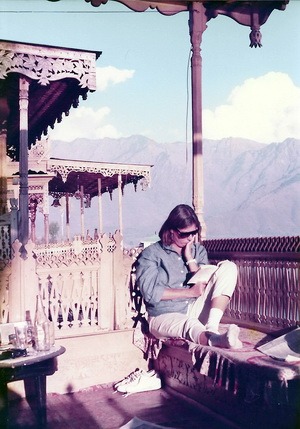
As the sun warms up the day, life on the lake becomes busier. What we call the “supermarket” shikaras bustle about offering daily necessities. The tourist versions are more sedate and feature shimmering canopies and curtains in red, yellow or white. Children paddle simple, smaller wooden versions, often awash with water. Old men, swathed in blankets, sometimes smoking a hookah, squat at the front of their boats to paddle. And then there are the hawkers…
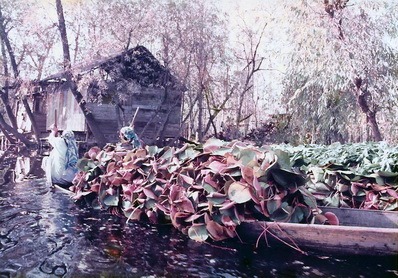
They paddle up when you are sitting on the verandah, they’ll even come and stand on the deck while you’re having breakfast inside: “perhaps you want to see my jewellery/shawls after breakfast, madam…”. And when you are out in a shikara they come alongside to show you their wares. They can be difficult to shake off. It’s a battle of wills; there are only so many shawls or bracelets or papier-mache boxes one wants or can even carry. Our houseboat owner appreciates that we don’t like being interrupted when we are on the boat, and he does warn some off. Though I expect it’s difficult for him: he wants us to enjoy our stay, but he may well get a commission if we buy.
We do buy “phiren” – the big cloak-like coat that the men wear in this cold weather, and we also get a little pot of coals to put in the bottom of the shikara under our coats to keep us warm on chilly days. I can’t remember whether we bought these from the floating salesmen or from shops in the old town.
Salesmen’s patter aside, a ride on a shikara is a relaxing way to pass the day. Lie back on the seats (advertised on the name board as “full spring seats”), glide past houseboats and compare them to yours — “ooh, they’ve got a bigger deck” — and laugh at the names – Neil Armstrong, New Neil Armstrong, Golden Fleece, Touson [sic] Arizona, New Australia. Ours is the sedate Royal Kashmir. The shikaras themselves have entertaining names, too – House of Lords, Kashmir Hilton, Big Happy Helen…
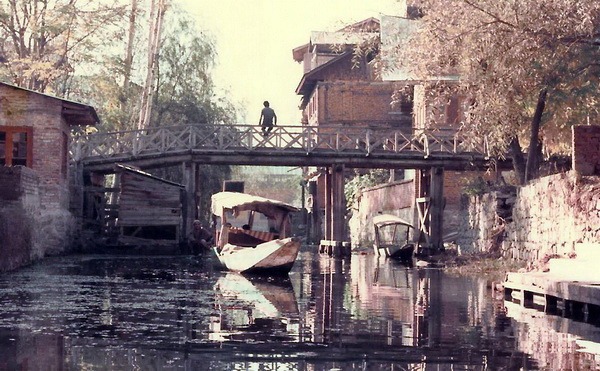
Past waterside shops selling souvenirs, household wares, or groceries. Wooden houses with enclosed balconies, newer brick houses. Children playing cricket. Women washing clothes in the lake waters. Shikaras laden with vegetation cut from the lake. In the afternoons it’s warm in the sun and there is little breeze, a taste (smell?) of what it must be like in high summer. Some days the air is so clear you can see detail on the snow-topped mountains that ring Srinagar. Late afternoon the sinking sun catches the top of the hills in the east and the clouds above them turn pink. The orange glow in the west is reflected in the lake, the shikaras turn into dark silhouettes. The moon is full currently: it lights up the lake and the hills – especially welcome when the electricity fails, which it does, frequently.
Late afternoon tea on the verandah, huddled in shawls and phiren cloaks, thick woolly socks and gloves all bought locally.
One evening there is a wedding party; picnic boats decked out with strings of lights. Bagpipes and drums sound as if the band of the Scottish Coldstream Guards is advancing upon us. Flashes and bangs of fireworks add to the imagery.
We looked at a handful of houseboats before we settled on the Royal Kashmir. Our hotel from the first night in Srinagar arranged for a boatman to take us out on the lake. We reject any too big and already partially occupied. The Royal Kashmir has only two bedrooms, and we do a deal with the owner to ensure we have it to ourselves. Including breakfast and dinner we are paying 475 rupees.
It is furnished in a style hardly changed since the latter days of the British raj. The interiors remind me of my granny’s house: flowery fabrics, heavy wooden furniture, acres of of inlay and carving. My diary records it as “chintzy”, which I decide to omit here on the grounds that this is a cliche, but on checking I find that “chintz” is a printed, glazed, bright floral fabric from India, so I feel it is appropriate. The houseboat is chintzy, very chintzy. And that is good.
Facing on to the lake is the covered verandah, with access steps down to the water. This is where we sit during the day if we are not out on a trip or on the water. This area leads into the living room with comfy chairs, bookcases, side tables, a TV and a wood-burning stove. A corridor runs down one side of the boat, with the dining room off to the side, and leading to an ensuite bedroom . There is another bedroom and bathroom upstairs, along with a kitchenette. Both bedrooms have heating stoves, and we have hot water morning and evening.
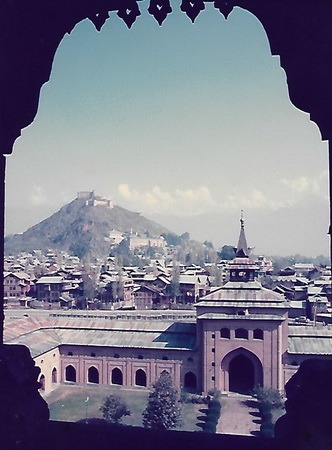
The family running the houseboat have their own quarters behind us landside. A young lad – the “house boy” – serves our breakfast and dinner in the dining room, puts hot water bottles in the beds in the evening, and lights the stoves, creeping into the bedroom at 6am to ensure it is toasty when we wish to get up. He goes off in his little boat to buy our supply of bottled beer, but he has less success finding tonic for our gin. Despite it being called “Indian tonic water” it’s not always easy to buy in the country, apart from in posh hotel bars. The houseboat owner introduces us to “gimlets” – adding Rose’s lime juice cordial to gin, and a big splash of of soda. I still drink them in India today (shoutout to the Palace restaurant in Hyderabad’s Abids district, which makes excellent gimlets).
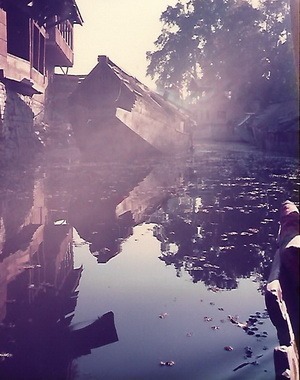
I cannot remember now where on the lake our houseboat was located. There are boats on either side of us, but we were out of season and they aren’t occupied. There are places on Dal where the boats are lined up next to one another like tour buses at Wembley Stadium. I can only imagine how noisy that could be. We do not have direct land access, but this doesn’t bother us at all. Our owner quickly organises a shikara whenever we want one, but much of the time we are only too happy to laze on the verandah, reading our books, and gazing at the view.
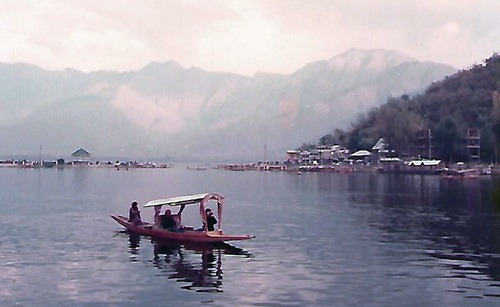
Serenity… 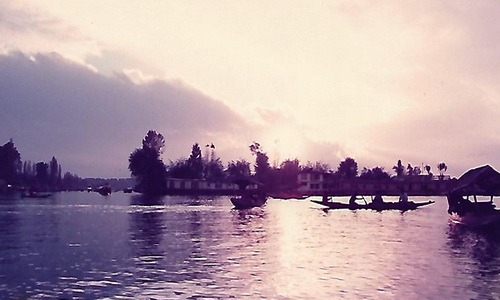
and peace
Scenes Away from the Lake
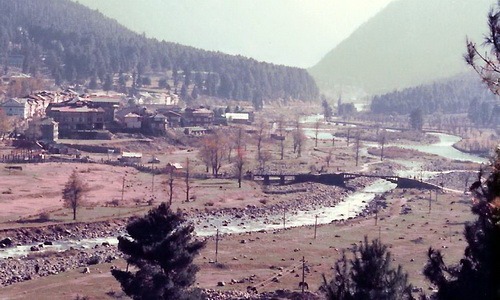
We take two trips: to Pahalgam, southeast of Srinagar, and to Gulmarg in the west. Both tours are with the local SRTC company. The tinny buses bump and rattle along the fractured roads. Basically it’s just the bus ride, and once you get to the destination you do your own thing until the agreed meeting time for the ride back. Indians are great travellers in their own country and really do enjoy getting out and about. We are the only Westerners on both trips. We do encounter a few other international visitors in Srinagar: Westerners in ones and twos, and the occasional solo Japanese.
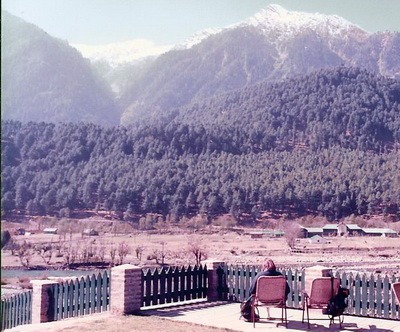
Along the way we see workers in the fields threshing corn by hand, oxen pulling wooden ploughs, purple saffron flowers and the brown earth. Women with headscarves jauntily tied back, showing friendly, open faces. The road winds up, streams tumble over boulders, waterfalls, past villages where men sit cross-legged in front of tailors shops and general stores. Pony men are at both places, even more persistent than the hawkers on Dal lake.
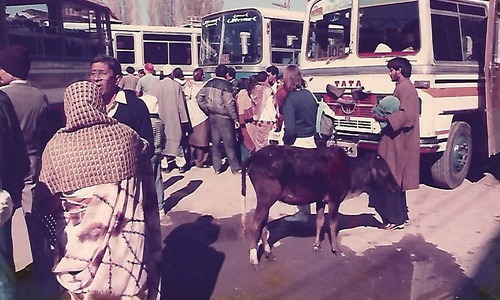
Pahalgam – we visit a hotel set in garden overlooking a river and have a late lunch of samosas, chicken tikka and beer, taking in the view, then a walk on the empty golf course. Pines, snowy peaks, soft grass, and peace! The road to Gulmarg climbs up and up. There’s a good hotel there, too, with a wonderful bar that looks like a ski lodge, it’s warm inside and has views over yet another golf course and more peaks. We indulge in hot toddies. This day is cold and damp; several of the Indian men on the bus have commandeered shower caps from their hotel bathrooms as head gear.
Coming back from Pahalgam there is a thin veil of mist over the fields, birds swoop low over the earth, and up and over the tree tops and the roofs of the wooden houses. Villagers huddle around fires, and the smoke mingles with the mist.
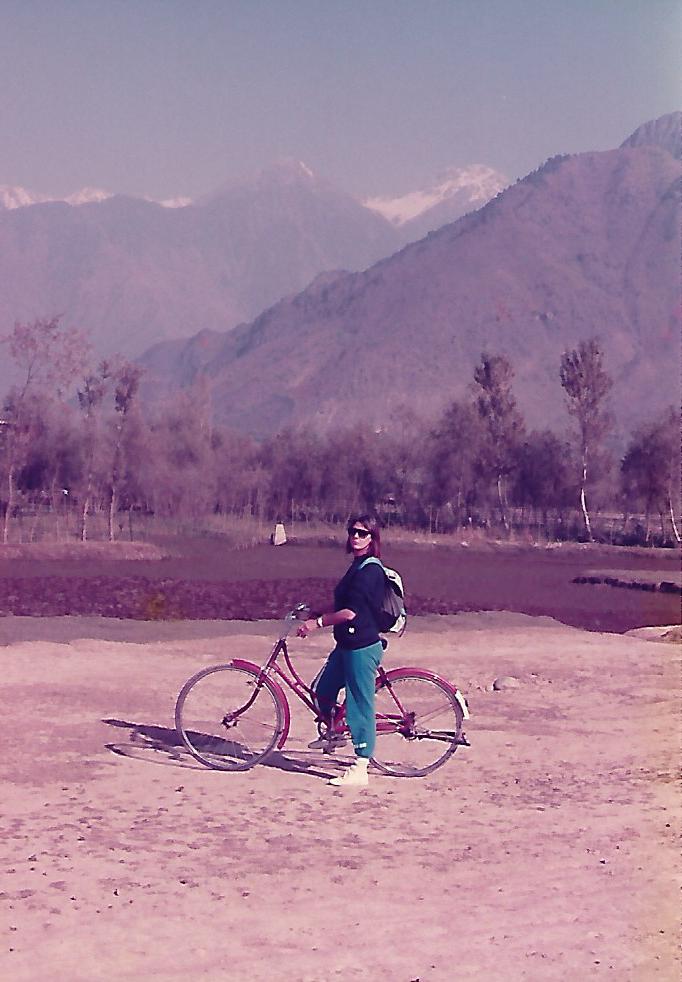
I can’t believe that I actually wrote in my diary “Bike riding was perhaps the best day here…”
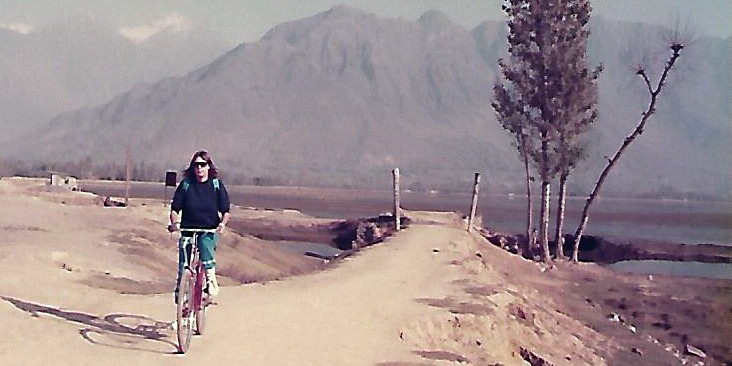
The route that goes around the lake is flat, so biking is an ideal way to see the area. We head off along the Boulevard; first stop the N… Gardens [I obviously meant to check the name and fill it in later. I see on Google maps that there is a “Nishat Bagh”, so it could well be that]. Then on to the Shalimar Gardens built by the Mughal emperor Jahangir, where we have the packed lunch provided by the houseboat. [Ah, Indian “packet lunches” – love them.] We follow the as-yet-unfinished and very bumpy causeway road skirting the north of the lake [this now appears to be Foreshore Road, and the area is built up – there was little in the way of buildings in 1987]. One part of the causeway is so rickety I have to be cajoled to ride over it. We turn down the west side of the lake and into the old city. My backside is extremely sore by the end of the day and I have great difficulty sitting comfortably for the next 24 hours – but it was a fascinating day and worth it.

Can you stay on a houseboat today?
Yes, you can. But Covid-19 has obviously had a huge impact on international travel, as well as travel within India.
There are other factors to consider, too. Political unrest in the state of Jammu and Kashmir, particularly in Srinagar, since 1989 has had a devastating effect on tourist numbers and infrastructure. Visitor arrivals have crept back up over time, especially among Indians themselves, albeit with fluctuations following particularly violent incidents. Houseboats are popular with honeymooning couples and family groups, in particular. Gulmarg has developed into a significant winter holiday destination. A houseboat stay in Kashmir doesn’t seem to figure highly on Westerners’ must-see lists these days (Kerala seems to be the houseboat spot for them), but I’ve seen a few Asian bloggers posting about stays.
The other big issue is pollution. Yes, waste from the houseboats goes straight into the lake. But there are a lot of other on-land businesses, including hotels, that also discharge effluent into the waters. You may want to think about this one, and consider if you really want to contribute to the problem.
This article, written in October 2020, tells the story of Kashmir’s last houseboat builder and how he sees no future in the craft. On the other hand, Blogger Sharell Cook published this guide to choosing a houseboat in January 2020.
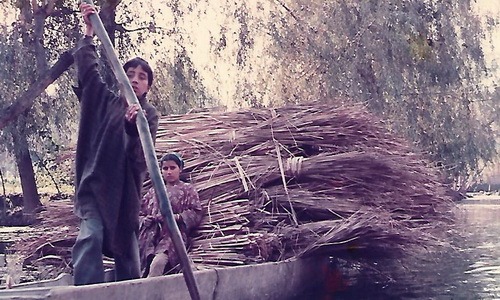
Update March 2021
On March 8, 2021, UK newspaper The Guardian published a story on how “pandemic may finally sink Kashmir’s famous houseboats”. It seems the ban on repairing the boats is now being strictly enforced (I found conflicting evidence when I researched it earlier).
